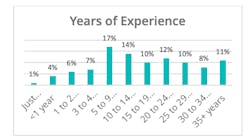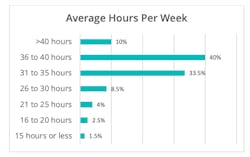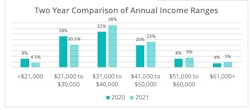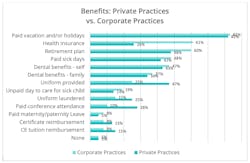DentalPost dental assistant salary survey: The future is promising
From late July through early September 2021, DentalPost and Endeavor Media, including Dental Assisting Digest, partnered to conduct the largest and most comprehensive dental professional salary survey of its kind. From compensation to work environments and job turnover rates, here are some of the key numbers and insights from responding dental assistants.
Related reading
The results of our dental front office staff survey are in!
The annual dental professional salary survey
Dental assistant survey audience demographics
Ninety-six percent of the responding dental assistants were female, with 48% between 25 to 44 years old. Thirty-seven percent are the sole income earners in their households. Eighty-five percent of respondents have completed a college-level program in dental assisting, while 50% reported they have expanded duties certification and 45% have DANB certification.
The majority of respondents (76%) assist general dentists, and the remaining 24% assist dental specialists. Forty-five percent work with office teams of five to 10 members, and nearly 22% work on large teams of more than 15 members. Seventy-five percent of responding dental assistants work in private practice settings, while 16% work in corporate practices. Of the 9% who responded “other,” they assist ib public health facilities, community clinics, hospitals, universities, military facilities, prisons, and public schools.
One out of five DAs work in more than one dental office
Just over 21% percent of this year’s responding dental assistants reported they work more than one job. Seventeen percent reported they work a side job that is nonclinical in nature. Eighty-four percent of respondents said they work more than 30 hours per week, and 10% work more than 40 hours a week. Just over half (57%) said they are satisfied with their hours.
Many dental assistants also do phone and administrative work
Nearly half of the responding dental assistants said they perform “front office” duties in addition to their clinical duties. One in three respondents said “treatment coordinator” is part of their job title. Since COVID-19, 49% have been asked to take on additional responsibilities beyond their normal job description. Only 18% said they are being compensated for those additional responsibilities.
Dental assistant income is rising
This year, 44% reported they received a pay raise in the last 12 months, and another 25% reported a pay raise in the last one to two years. In 2021, 61% of the full-time dental assistant salaries ranged from $31,000 to $50,000. Fourteen percent earned more than $50,000, compared with 12% in 2020. In the last year, the percentage of dental assistants earning less than $20,000 per year dropped from 8% to 4.5%. Nine out of 10 assistants are paid hourly, and their average hourly wage is $21.95. Of the 8% who are paid a salary, 50% earn a base salary between $30,000 and $49,000. Despite these improvements, only 24% reported they felt satisfied or very satisfied with their total income.
Note to dental hiring managers: 67% of those who reported being “satisfied” or “very satisfied” with their income received a pay raise in the last year.
Income by state
Dental assistant salary survey respondents covered every state in the country except Alaska, District of Columbia, Hawaii, and Montana.
Highest paying states: The states with an average reported income between $46,000 and $50,000 are California, Oregon, Virginia, Utah, Minnesota, Washington, and Massachusetts.
Lowest paying states: The states with an average reported income of less than $30,000 are Louisiana, Wyoming, Kansas, West Virginia, Kentucky, Mississippi, Oklahoma, and Tennessee.
Employee benefits are important
Beyond compensation, employee benefits are important to dental assistants. Ninety-seven percent said that benefits matter to them. In private practices, only 4.75% of respondents said they do not receive any benefits. In corporate practices, only 5.25% of respondents said they do not receive any benefits. This year we asked specifically which benefits they receive.
Turnover could be dropping
Thirty-seven percent of all dental assistants said they interviewed for one or more new jobs within the last year. Just over a quarter (27.5%) plan to look for a new job in the coming year. Only 4% plan to retire in the next two years. No one reported they were considering leaving the profession.
What job seekers want
Among those who plan to look for a new job, higher pay is top of mind for 49% of respondents who included comments in their survey response. This is followed by a desire for a more respectful and appreciative work environment (35%), and a desire for health and retirement benefits (8%).
About the survey creator and survey copromoter
As the largest dental job search board in the industry, connecting 900,000 dental employees with 70,000 dental practice employers, DentalPost is uniquely positioned to partner with Dental Assisting Digest in keeping dental professionals informed of the latest data and survey results surrounding their compensation, working environments, and career choices. Founded in 2005 by registered dental hygienist Tonya Lanthier, DentalPost leads the dental industry in metric-based career matching, including personality tests, work culture preferences, skill matching, and career goal assessments. Learn more about DentalPost and view the comprehensive 2022 Dental Assistant Salary Survey Report at dentalpost.net.
About the Author
Tonya Lanthier, RDH
Tonya Lanthier, RDH, is founder and CEO of DentalPost, the dental industry’s premier and largest online and mobile job board, connecting and educating more than 850,000 job seekers and 64,000 dental offices in the US and Canada. Lanthier built DentalPost from a passion to improve lives and help dental professionals build teams that excel through metric-based career matching tools, including personality tests and values, skills and work culture assessments. She is a member of the American Dental Hygienists' Association (ADHA), Entrepreneurs' Organization (EO), a supporter of AACD's Give Back a Smile program, and a volunteer at several charitable organizations, including Georgia Mission of Mercy and Ben Mansell Clinic. Lanthier is also a board member of the Oral Cancer Cause and Dental Entrepreneur Women.





